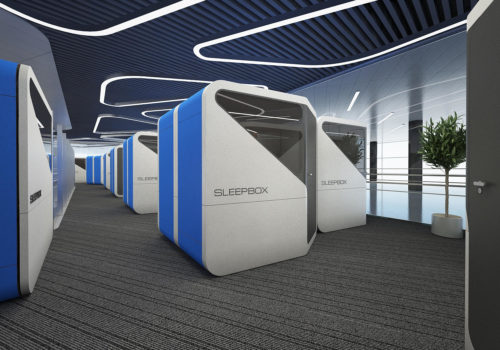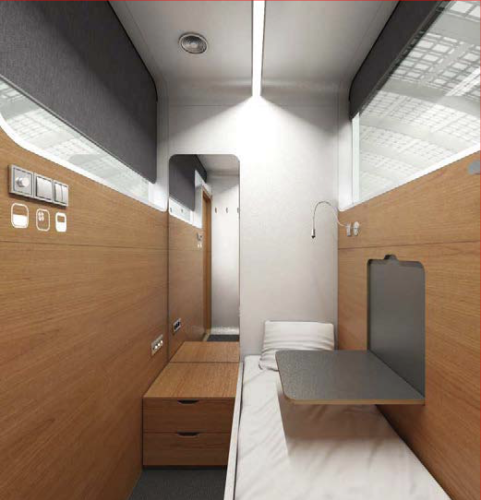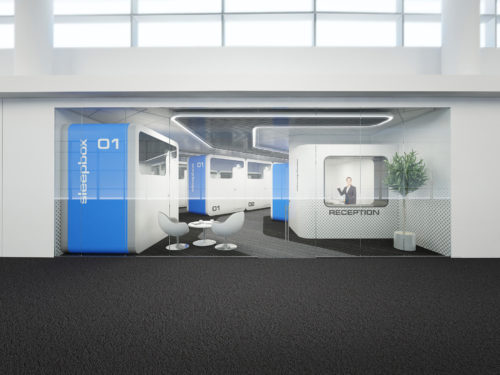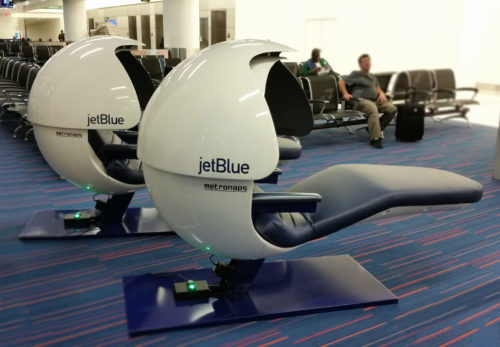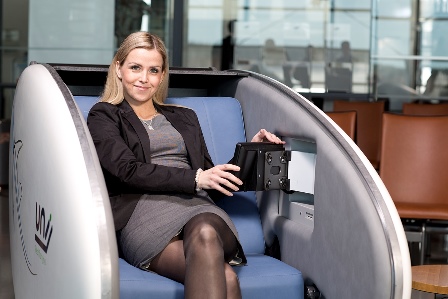My “At the Airport” column in USA for July 2017 was mostly about a new company hoping to bring relief for travelers stuck at the airport with an easy to install napping pod. I’m posting a slightly different version of that column here on Stuck at the Airport in case you missed it.
Airports and the passenger experience may soon change thanks to everything from biometrics, robots and customer data mining to augmented reality, ride-sharing, autonomous transportation and new screening technologies.
All that – an more – was on the agenda recently at a gathering of industry leaders that included airport employees with the word “innovation” in their job titles.
The Airport Innovation Forum, organized by the American Association of Airport Executives, capped off with a Shark Tank-style competition in which five startups competed for a spot in the Airport Market Match program.
I was part of a panel of judges that included innovation experts from Microsoft and Amazon and an aviation industry insider. And while we grilled the contestants for details on their business plans, it was up to forum attendees using an instant electronic polling system to choose the winners.
Competing ideas included an app designed to help visually impaired travelers navigate airports (Loud Steps), a mobile app to monetize passenger loyalty (Venuetize), and a platform that analyzes mobile device location data for insights on passenger behavior (Kiana Analytics).
But the two (tied) winners were Bellevue, WA-based Alitheon, a company whose proprietary computer technology can very accurately and security authenticate, track, trace and monitor baggage without the need for barcodes, tags or RFID chips, and the passenger-friendly “sleep vending machines” created by Boston-based Sleepbox.
Airport naps as innovation
Airport operators and security teams will be most interested in the services of contest winner Alitheon, but being able grab a bit of shut-eye when you’re stuck at the airport ranks high on most every traveler’s wish list.
“We think we have a solution that can eliminate one of the worst airport experiences,” said Peter Chamber, Sleepbox Chief Operating Officer and co-founder,
The self-contained, plug-in Sleepbox units are just that: efficiently-designed 45-square foot boxes with a window to the outside and, inside, a bed, storage space for carry-on luggage, a wireless stereo system, fold down work table, wall mirror, lighting and electrical outlets. Units come in three sizes: basic (“InnerSpace”), single or double.
The original design called for the united to have self-changing sheets, with a new set-up unwinding from a bed-linen roll after each use. And while Chambers still likes that idea, the current design has an attendant doing clean-up duty.
Positive reaction and a flurry of “We need this now!” press coverage in response to a prototype Sleepbox set up for three months in 2011 at Sheremetyevo International Airport in Moscow, Russia and success with a hotel-use set-up in Stockholm convinced the creators they had a good idea.
Of course, they aren’t the first to have this idea.
Road warriors may remember Laptop Lane from the late 1990s. The company rented fully-equipped private mini-offices with desks, computers, Wi-Fi, walls and locking doors in, eventually, about two dozen airports nationwide. While these units didn’t have beds, they were often rented by travelers who needed a place to nap.
For a short time around 2004, stylish sleep pod chairs from Metro Naps, with special sleep music and a gentle wake-up program of lights and vibrations, were available to weary travelers at Vancouver International Airport.
Prices and stay requirements vary for each style of napping nook, but today travelers will find sleeping cabins by NapCabs in both Munich Airport and Berlin-Tegel Airport in Germany, GoSleep sleeping pods in the Abu Dhabi and Dubai airports and Minute Suites – equipped with daybed sofas, HDTV (that can be used as a computer) and work tables – in Philadelphia International Airport, Dallas-Fort Worth International Airport and in Hartsfield-Jackson Atlanta International Airport.
The Yotel hotel chain also offers airport sleeping cabins with beds, work spaces, TV and private bathrooms (with showers) in London’s Heathrow and Gatwick Airports, in Paris Charles de Gaulle Airport and in Amsterdam Schiphol Airport.
Chambers believes there’s room for the Sleepbox concept in the airport (and hotel) napping market in the United States and says the company currently recently presented its proposal to install a bevy of Sleepbox units (10 to 20) in a former airport lounge at a major US hub.
The recent Airport Shark Tank win offers Sleepbox needed exposure and credibility, said Chambers, “It’s always difficult getting a new idea into an airport, but being part of AAAE’s start-up accelerator program will help match us up with airports where we can pilot the project.”
